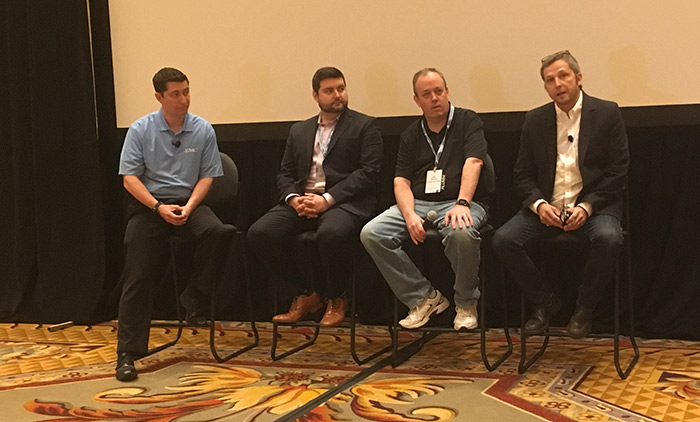EMC World 2016: Avatar Production Company Embraces the Digital Movie Revolution
How’s this for a splash of cold water in the face: The film industry is dead.
This jarring statement wasn’t made by some brash, cord-cutting upstart. It was said onstage Wednesday in front of thousands at the 2016 EMC World conference in Las Vegas. And the person who made the claim might be even more surprising. Jon Landau is a producer at Lightstorm Entertainment, world renowned film director James Cameron’s production company.
“Film to me doesn’t exist anymore. When people come by our studio facility in Manhattan Beach, I bring them outside of the door and the door is to the machine room with the EMC equipment,” Landau said. “I walk them in and I go, ‘We’re not in the film business anymore because it’s all digital.’ I open the door and there’s our machine.”
Hollywood’s Digital Transformation Journey
Landau’s and Cameron’s film credits include the Academy Award-winning films Titanic and Avatar, so his observation of the state of the film industry carries a significant amount of weight.
“Everything we do from concept art through editorial to marketing to sharing assets with other partners, it is all digital,” said Landau.
Landau’s point-of-view is particularly impactful given the ground that he and Cameron broke with the first Avatar film in 2009. The box-office blockbuster single-handedly launched the 3D movie phenomenon that is commonplace now.
A common theme at EMC World was about how “digital business” is the new normal. Lightstorm Entertainment is already embracing that mantra, but on top of being a digital business, they actually have to create a digital world with Pandora, the fictional planet where the Avatar films take place.
“We design a world. We design it digitally in computers. And rather than turning over our designs to construction crews who use lumber and nails to build sets, we turn it over to digital artists. They build the sets,” he said.
So Much Data It Can Fill a Lake

Tim Bicio (far right) of Lightstorm Entertainment spoke about his experience using EMC's Isilon and Data Lake solutions during a panel discussion at EMC World.
When you shoot a film entirely in 3D and chock-full of CGI, you can expect that it’ll take up a lot of storage space. How much space, exactly? Lightstorm used a whopping 2 petabytes to create the first Avatar film. Landau forecasts that the production company will end up using somewhere in the neighborhood of 12 petabytes for the coming Avatar sequels.
In order to pull off the level of management that Lightstorm needs to produce the Avatar films, it needed a better storage solution that could scale and operate under a demanding Big Data environment. Especially since production and post-production work happens globally, not just locally.
“The challenge is how do we push all of this data we’re capturing, not just to Los Angeles but to our partners at Weta Digital in New Zealand and other places,” said Landau.
EMC’s Scale-Out Data Lake solution built on its Isilon storage products did just the trick for the production company. The value of a data lake, a single central repository of persistent data, is huge for the Lightstorm team because it enables workers to access historical and current data without productivity interruption or heartache.
“For us to be able to have data from the first movie that is easily accessible for those who need it, but it’s not cumbersome for those who are just working on the upcoming movies [is essential],” said Landau.
To be clear, accessibility of historical data isn’t a just nice-to-have addition for Lightstorm. When every single character, background detail and special effect is digitally created, the company can’t afford the time or resources to endlessly recreate things.
“We’re building four sequels. If you think we’re not going to use the assets we’ve already built, we’re just gonna build them again, you’re crazy,” said Tim Bicio, chief technical officer at Lightstorm Entertainment, during a customer panel at EMC World. “This stuff has to be available to our artists.”
Smart Storage Improves Movie Making for Creatives and IT
There are some who might view the infusion of technology into the movie-making process as a negative. The perception that technology complicates things, especially in a field where restrictions on creativity are frowned upon, is one that Lightstorm’s IT team works hard to fight against.
Bicio believes ensuring the creative output of the team is one of his main responsibilities as the head of IT at Lightstorm.
“Most of our users are highly creative people, including Jim [Cameron]. If my creative people are frustrated, they’re no longer creative,” he said. “So if we’re presenting everything and it’s exactly where they would expect it to be, and they can work off of that data and start their work without waiting, and without having to look for it, they’re gonna spend more time thinking as a creative.”
One of the things that Bicio and his team take seriously is their role in improving processes and learning from previous experiences. On the first Avatar film, the company used Isilon storage, but it used other storage solutions for archive and offsite recovery. That’s why EMC's Data Lake, which offers a unified storage pool, was such a relief.
“Data Lake allows us to meticulously present all of our storage and all of our data to our end users as though it’s local,” said Bicio. “So I can put cold data at our colo facility on high-density Isilon or I can put historical Avid media on Isilon locally. I can have production data and render hitting the fast nodes in production and nobody’s the wiser.”
For Bicio, who has a very small IT team, freeing up resources to tackle other tasks besides retrieving data is a big win.
“That takes a load off my team,” said Bicio. “I don’t have to have three to four guys handling data. I have Data Lake handling data for me.”









